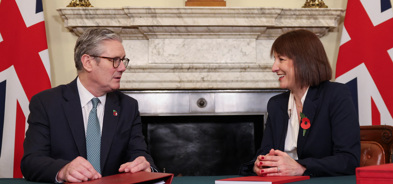5 key themes for breaking the bad news cycle
We still find reasons to be optimistic on stocks in the second half of 2023 yet it’s an environment that requires careful navigation. Here are the five key themes we remain focused on for the months ahead.
The value of investments can fall as well as rise and that you may not get back the amount you originally invested.
Nothing in these briefings is intended to constitute advice or a recommendation and you should not take any investment decision based on their content.
Any opinions expressed may change or have already changed.
Written by Daniel Casali, Chief Investment Strategist
Published on 02 Aug 20235 minute read

The first half of 2023 has been better than anyone dared hope at the start. To date, most major world economies have avoided recession, with financial markets in positive territory over the year. However, there are challenges: a US recession remains a risk and stock markets have been narrowly led by a handful of Artificial Intelligence (AI)-related stocks.
Overall, we still find reasons to be optimistic on stocks in the second half of 2023. Economic growth has been stronger than forecasted, and expectations of recession have been pushed out to next year. China’s reopening has also provided a boost, albeit not as vigorous as initially hoped.
Stable growth is supporting a weaker US dollar, which tends to be good for non-US equity markets and is part of the reason for stock market resilience this year. We believe this dollar weakness has further to run. Equally, while geopolitical risks continue, the likelihood of a significant shock has diminished. Overall valuations – barring some areas of the US - remain relatively undemanding.
However, it is still an environment that requires careful navigation. We remain focused on five key themes for the months ahead:
1. Momentum behind stocks
With the S&P 500 rising over 20%[i] from its October lows, the US has now entered a bull market. Bull markets tend to last a lot longer than bear markets, where a stock market falls 20% or more from its peak, with an average duration of five and a half years. We’re only nine months in so far. Once a bull market becomes established, some animal spirits emerge, and it starts to become a stimulus for the overall economy, through business and consumer confidence, plus the wealth effect. At the same time, short-selling pressure has diminished, with traders unwinding their positions. This could support the market in the coming months.
2. Focus on semiconductors
While stock markets have risen this year, they have been narrowly led by a handful of artificial-intelligence related companies. Should AI prove to be the catalyst for global growth that many hope, this could endure. Yet among the major AI-related technology companies, it is difficult to know who will emerge as the winner. We prefer to play this theme through the ‘picks and shovels’. That means owning more of the semiconductor companies, who are manufacturing the chips required for the big data analytics that drive AI.
3. Sticking with Asia ex Japan
China’s reopening has disappointed. The economy has not revived as quickly or as robustly as many had hoped. Nevertheless, it is still providing a boost for the region. In Asia, earnings growth has picked up quite substantially and is now running at more than double the level of developed markets. This is partly attributable to AI and expectations of stronger economic growth. The visibility for earnings across the region has improved, particularly among the chip makers in Taiwan and South Korea.
4. Adding bond risk
It looks like the US is heading towards the end of its rate rising cycle. The Federal Reserve paused in June, and while there may be a 25bps rise in July, further hikes are unlikely. The European Central Bank also looks close to the end of its cycle, though there is more work to be done for the Bank of England. While there remains some uncertainty on inflation, we see less room for a significant spike in yields from here. This should be supportive for bond markets. Investors can access and lock in the current yields on offer by investing in longer dated bonds – adding duration.
5. US dollar depreciation and gold appreciation
The dollar is a counter-cyclical currency and generally weakens at times of improving economic growth. There has been a stronger global recovery than expected with Europe avoiding an energy crisis, the US avoiding recession (so far) and China reopening after Covid lockdowns. This has improved investors’ risk appetite, which has been bad news for the ‘safe haven’ dollar.
Our view is that the dollar will continue to depreciate from here as its recent run of strength unwinds. However, it does not yet face any real challenge to its long-term position as the world’s reserve currency.
Read Down with the dollar for more on this.
Gold has been resilient. Returns have not been significant, but investors tend to own it for its insurance purposes. As interest rates increase, an asset which generates no income, such as gold, usually comes under pressure. However, there is a lot of central bank buying of gold, particularly in countries in dispute with the US – notably Russia and China.
Headwinds
The factors which could impede an economic recovery are clear. Perhaps the most important is the lagged effect of monetary tightening. Central banks have raised interest rates significantly, while banks have been tightening lending standards. It may be that the effect of this has only partially worked its way through the system. That said, many companies have already refinanced at lower rates, and profit margins are high. This mitigates the impact of rising interest rates and improves the capacity of companies to deal with them.
It is clear that inflation is not yet back in the box, although the US is much further along the road. Pent-up demand for areas such as holidays and leisure activities is driving demand for services and inflation. Wage growth in UK has been moving sharply higher. The greatest issue for the Bank of England governor Andrew Bailey is wage rises risk becoming entrenched.
The final headwind is the ongoing geopolitical tensions. While the geopolitical risk indicators have come down from their highs, there are plenty of political flashpoints over the next 12 months, from NATO’s summit in Lithuania, to the BRICS leaders’ summit in Cape Town. There are presidential elections in Taiwan and US electioneering will start in earnest in the last quarter of 2023.
Nevertheless, even with these headwinds in mind, we believe markets are breaking the bad news cycle. Recession, if it comes, is likely to be weak. AI investment could drive markets forward. Asia has some exciting opportunities and yields in the bond market now look appealing. We are hopeful that the second half of the year should bring greater clarity – on inflation, on interest rates, and on the path ahead for the global economy.
By necessity, this briefing can only provide a short overview and it is essential to seek professional advice before applying the contents of this article. This briefing does not constitute advice nor a recommendation relating to the acquisition or disposal of investments. No responsibility can be taken for any loss arising from action taken or refrained from on the basis of this publication. Details correct at time of writing.
Sources
i Refinitiv/Evelyn Partners
Important information
The value of investments, and the income from them, may go down as well as up and investors may not get back the amount originally invested.
Past performance is not a guide to future performance.
Underlying investments in emerging markets are generally less regulated than UK ones. There is an increased chance of political and economic instability with less reliable custody, dealing and settlement arrangements. The market(s) can be less liquid. If a fund investing in markets is affected by currency exchange rates, the investment value could both increase and decrease. These investments therefore carry more risk.
Get insights and events via email
Receive the latest updates straight to your inbox.
You may also like…


Market news
2024 Autumn Budget Overview: The key announcements from Chancellor Rachel Reeves




